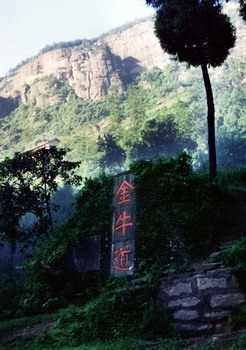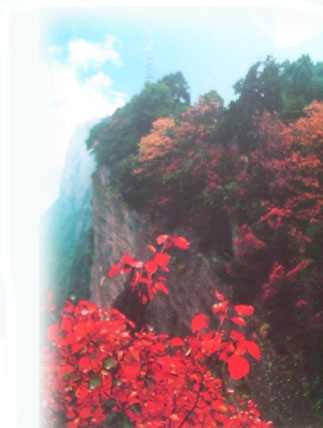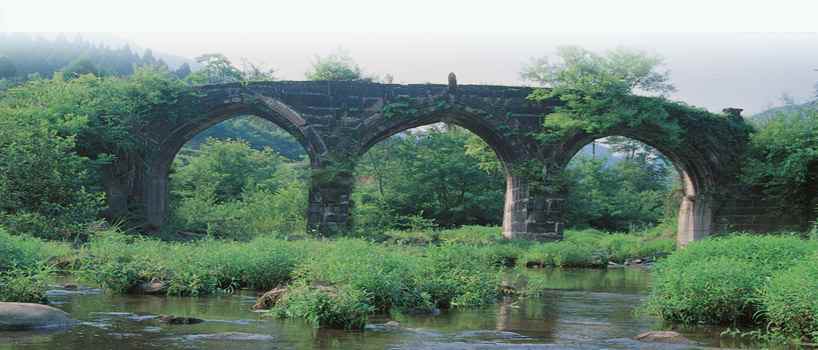|
|
The Story of Ancient Golden Bull Trai
|
According to ancient records in books like 〈Hua Yang Guo Zhi〉, 〈Shu Wang Ben Ji〉 and 〈Shui Jing Zhu〉, in the middle to late periods during the Warring States Era, Qin Hui Wang, seeing that the 12 th generation of the ancient Shu Kingdom was declining in power and that the Shu King was debauched, wished to invade Shu. But Qin and Shu were separated by hugh mountains and there were no passage ways. Perhaps Qin Hui Wang strongly believed there was a deep tradition of Shu people in superstitions and witchcraft, he came up with the idea of carving 5 gigantic bulls in rock and presenting them to the Shu king. Gold was laid on their tails and the bulls were ostentatiously grazed by shepherds. When Shu people saw the bulls, they were led to believe that these were heavenly bulls which could discharge gold. The Shu king was overjoyed and sent five mighty and powerful men to build a passage way so as to pull the bulls all the way back to Chengdu . But, thanks to the passage way, Qin soldiers could speedily invade the Kingdom of Shu . This is the legend of ‘'Five Men Breaking Through Mountains'. And the passage way was named ‘Ancient Golden Bull Trail', which is also the origin of the Jian Men Shu Passage Way.
Another legend has it that Qin Hui Wang gathered that Shu Wang was lustful and therefore promised to present to him five beautiful girls. Shu King sent five mighty men to build a passage way to receive them. But when they arrived at the border of Zi Tong, a hugh snake was seen crawling into a stone gap. One of the men grasped its tail and tried to pull it out, to no avail and the five all pulled together, causing a crumble in the mountains and all five mighty men and the five beautiful girls were submerged. This is the origin of the line in Li Bai's poem ‘Tribulations of Shu Trail'. The line says ‘death for the might men in the crumble of the mountains, then saw the rocky roads and heavenly steps linked' .
|
 |
|
The Legend of the Coral Cliff
On the east cliff of the Jian Men Guan mountain pass there is a light red mark, the colour of which varies from the weather, sparkling gold under the ray of sunshine, or dark red in murky rain and mist People called it ‘The Coral Cliff”.
|
 |
According to the Qing scholar Yuan Mei in his ‘Sui Yuan Shi Hua’, in the Five Dynasty period Song conquered Hua Shu, and the palace of which collapsed instantly. Everyone ran for their lives. The commander of the Song army Wang Quan Bin ordered a thorough search in Chengdu. In a farmer’s cottage in the country a maid of honour was found. Her name was Yuan Ju, 18 years old, very pretty. She talked elegantly and was good in poetry and expression, music and painting, and was considered an unequalled bombshell. She had been exclusively serving Lady Blossom in the palace for three years. Lady Blossom and Yuan Ju were both sent under guard to the capital. When they went past the Jian Men Gate over the Da Jian Stream, pondering upon the ravage of their home and country, and the repeated defilement that was too hard to bear, they jumped over to the stream. And soon after, a mark in the shape of a Coral tree was visible. on the cliff over the stream. People then called it Red Tree Coral.
|
|
The Precipice of Self-Sacrifice
The precipice is next to the Liang Shan Temple, about 10 metres from its main entrance. The rocky precipice is very steep, and a television tower is standing right on the hilltop. Clinging onto a tree trunk and looking down, one can't help shuddering and shivering. And only the adventurous ones would dare. Legends about the precipice, at once moving and pleasant, circulated for hundreds and thousands of years. At the beginning of the Ming Dynasty, there was in the royal court a general, an expert in warfare and highly commendable in military achievements. In discerning the evil of the bureaucracy and the corruption of the royal court, he decided to become a monk in the Liang Shen Temple, and to live a secluded life. He was given the Buddhist title of ‘Zhi Song'. Being reticent, friendly and learned in Buddhism, he was much adored by his fellow monks and was elected as chief of the
|
temple. One evening while he was cooking, there was an unexpected visit by a lady patron of around 30 years old, who, despite dressing in an unaffected fashion, was comely and fair, pretty and attractive. Seeing that Zhi Song was sturdy and in excellent spirits, she asked, ‘I can see that you have an unconventional bearing, a dignified look and a mastermind, why on earth are you here in the deep mountains and ancient forests practicing Buddhism ?’Zhi Song gave no answer. And the lady asked again, ‘I have been widowed for some years now, lonely but possessing a small fortune. If you intend to live a lay life again, how about tying the knot and living contentedly together for the rest of our lives ?’ Zhi Song was now a little annoyed. He who used to strictly follow the prohibition Buddhist rules now tried to keep his anger in check and answered calmly, ‘I abide by the Buddhist discipline and reject all earthly desires. Would that your ladyship please behave yourself.’ No matter how hard she tried to persuade him, he remained unmoved and concentrated on his duties, as if there was nobody there in his eyes. Seeing that her words were in vain, she came forward and pulled his sleeves. Zhi Song was now enraged, raising his eyes and picking up a rod, he began to expel her. She turned and ran, and jumped down the precipice, unquestionably trying to end her life. Zhi Song thought to himself, that a monk should not have caused such a fatal disaster, which could have no excuse under the Buddhist discipline. He therefore made a jump too. It turned out that the lady patron was in fact a substitute of the bodhisattva, here to put Zhi Song to the test intentionally. Zhi Song’s piety was now confirmed, and the bodhisattva caught and saved him with a piece of auspicious cloud and delivered him to the Elysium This precipice is therefore right named ‘The Precipice of Self-Sacrifice’. It gave the Jianmen Mountain an additional tourist attraction.
|
 |
|
Graceful JianXi bridge
2 km from Jianmen Pass is the Da Jian brook, and a bridge on which was there from Ming dynasty that more than 500 years, but still graceful.
Bracken color, thickness stone pillar, stone bar like key board of the piano has abraded, deformity stone animal decoration…. This is the first impression of Jian Xi bridge give to people. Jian Xi bridge is the only remained arch bridge of Ming dynasty, it’s the way to Jian Men Shu’s road, 18 meters legth, 7 meters height. As 〈Jian Zhou records〉, this bridge has been built on Hong Zhi year of Ming dynasty (1488-1505), had already been there more than 500 years. There are 4 stone piers, and the arch are still keep as before, the stone bar on the surface of the bridge didn’t distroed too much, and 14 stone pillars and balusters now only remained 5, the others just could find the marks.
An old person named Dong who is browse the ox introduced, local people had respect Jian Xi bridge a lot. As devolution, When built the Jian Xi bridge, people hide the magic inside, so even some times Jian Men mountain’s got flood, but never overstep the surface of the bridge to make the road interdiction. When he was about 5-6 years old, the bidge was already like this, and the pillars at the side edge had settled a toad decoration, now just details were distroied, but still can realized the shape. The bridge approach had 12 steps of stone bars, and not distroied too much also.
A arch bridge today is not just a bridge, but also take a lot of culture, all nature sights will come to the culture in the end. Maybe this is the reason when tourists whom visisted a lot of placed, when they come to the bride, they paid more attention on?!
|
 |
|





